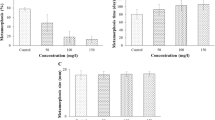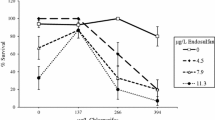Abstract
Human activities have introduced a variety of chemicals, including pesticides, fertilizers, and salt, into the environment, which may have deleterious effects on the organisms inhabiting these areas. Amphibians are especially susceptible to absorption of chemical pollutants. To determine the possible combined effects of these chemicals on amphibian development and stress levels, Southern leopard frog (Lithobates sphenocephala) larvae were exposed to one of eight individual or combined treatments of atrazine, ammonium nitrate fertilizer, and sodium chloride salt. Stress levels, indicated by release of the stress hormone corticosterone, were measured premetamorphosis at week 8 of development. Water hormone samples were processed to analyze corticosterone levels. Changes in tadpole growth were determined by surface area measurements taken from biweekly photographs. The combined chemical treatment of atrazine, salt, and fertilizer had a significant interactive effect by increasing stress levels before metamorphosis (p = 0.003). After a month of larval development, tadpoles exposed to ammonium nitrate had larger surface area (p = 0.035). Tadpoles exposed to atrazine had a lower growth rate throughout larval development (p = 0.025) and the lowest number of individuals reaching metamorphosis at 33%. However, the frogs in the atrazine treatment that did successfully metamorphose did so in fewer days (p = 0.002). Because amphibians are exposed to multiple chemicals simultaneously in the environment, assessing the effects of a combination of contaminants is necessary to improve application strategies and ecosystem health.



Similar content being viewed by others
References
Adams AJ, Pessier AP, Briggs CJ (2017) Rapid extirpation of a North American frog coincides with an increase in fungal pathogen prevalence: historical analysis and implications for reintroduction. Ecol Evol. https://doi.org/10.1002/ece3.3468
Allran JW, Karasov WH (2000) Effects of atrazine and nitrate on northern leopard frog (Rana pipiens) larvae exposed in the laboratory from posthatch through metamorphosis. Environ Toxicol Chem 19:2850–2855. https://doi.org/10.1002/etc.5620191133
Boone MD, Bridges CM, Fairchild JF, Little EE (2005) Multiple sublethal chemicals affect tadpoles of the green frog Rana clamitans. Environ Toxicol Chem 24(5):1267–1272
Brand A, Snodgrass J, Gallagher M, Casey R, Van Meter R (2010) Lethal and sublethal effects of embryonic and larval exposure of Hyla versicolor to stormwater pond sediments. Arch Environ Contam Toxicol 58(2):325–331. https://doi.org/10.1007/s00244-009-9373-0
Burgett AA, Wright CD, Smith GR, Fortune DR, Johnson SL (2007) The impact of ammonium nitrate on wood frog (Rana sylvatica) tadpoles: effects on survivorship and behavior. Herpetol Conserv Biol 2(1):29–34
Burraco P, Gomez-Mestre I (2016) Physiological stress responses in amphibian larvae to multiple stressors reveal marked anthropogenic effects even below lethal levels. Physiol Biochem Zool 89(6):462–472
Chambers DL (2011) Increased conductivity affects corticosterone levels and prey consumption in larval amphibians. J Herpetol 45(2):219–223
Charbonnier JF, Pearlmutter J, Vonesh JR, Gabor CR, Forsburg ZR, Grayson KL (2018) Cross-life stage effects of aquatic larval density and terrestrial moisture on growth and corticosterone in the spotted salamander. Divers 10(3):1–16. https://doi.org/10.3390/d10030068
Chinathamby K, Reina RD, Bailey PCE, Lees BK (2006) Effects of salinity on the survival, growth and development of the brown tree frog (Litoria ewingii). Aust J Zool 54(2):97–105
Correll DL, Jordan TE, Weller DE (1992) Cross media inputs to eastern U.S. watersheds and their significance to estuarine water quality. Water Sci Technol 26(12):2675–2683
Dananay KL, Krynak KL, Jrynak TJ, Benard MF (2015) Legacy of road salt: apparent positive larval effects counteracted by negative postmetamorphic effects in wood frogs. Environ Toxicol Chem 34(10):2417–2424. https://doi.org/10.1002/etc.3082
Davis AK, Connell LL, Grosse A, Maerz JC (2008) A fast, non-invasive method of measuring growth in tadpoles using image analysis. Herpetol Rev 39(1):56–58
DeNoyelles F, Kettle WD, Sinn DE (1982) The response of plankton communities in experimental ponds to atrazine, the most heavily used pesticide in the United States. Ecology 63:1285–1293
Gabor CR, Bosch J, Fries JN, Davis DR (2013) A non-invasive water borne hormone assay for amphibians. Amphibia-Reptilia 34:151–162
Gabor CR, Fisher MC, Bosch J (2015) Elevated corticosterone levels and changes in amphibian behavior are associated with Batrachochytrium dendrobatidis (Bd) infection and Bd lineage. PLoS ONE 10(4):1–13. https://doi.org/10.1371/journal.pone.0122685
Gabor CR, Davis DR, Kim DS, Zabierek KC, Bendik NF (2018) Urbanization is associated with elevated corticosterone in Jollyville Plateau salamanders. Ecol Indic 85:229–235. https://doi.org/10.1016/j.ecolind.2017.10.047
Gallant N, Teather K (2001) The differences in size, pigmentation, and fluctuating asymmetry in stressed and nonstressed northern leopard frogs (Rana pipiens). Ecoscience 8(4):430–436
Glinski DA, Purucker ST, Van Meter RJ, Black MC, Henderson WM (2018) Analysis of pesticides in surface water, stemflow, and throughfall in an agricultural area in South Georgia, USA. Chemosphere 209:496–507
Hall EM, Brady SP, Mattheus NM, Earley RL, Diamond M, Crespi EJ (2017) Physiological consequences of exposure to salinized roadside ponds on wood frog larvae and adults. Biol Conserv 209:98–106. https://doi.org/10.1016/j.biocon.2017.02.013
Harman-Fetcho JA, McConnell LL, Rice CP, Baker JE (2000) Wet deposition and air–water gas exchange of currently used pesticides to a subestuary of the Chesapeake Bay. Environ Sci Technol 34(8):1462–1468. https://doi.org/10.1021/es990955l
Hauer FR, Lamberti GA (eds) (2006) Methods in stream ecology, 2nd edn. Academic, San Diego
Howe GE, Gillis R, Mowbray RC (1998) Effect of chemical synergy and larval stage on the toxicity of atrazine and alachlor to amphibian larvae. Environ Toxicol Chem 17(3):519–525
Karraker NE, Gibbs JP, Vonesh JR (2008) Impacts of road deicing salt on the demography of vernal pool-breeding amphibians. Ecol Appl 18(3):724–734. https://doi.org/10.1890/07-1644.1
Kaushal SS, Groffman PM, Likens GE, Belt KT, Stack WP, Kelly VR, Band LE, Fisher GT (2005) Increased salinization of fresh water in the northeastern United States. PNAS USA 102(38):13517–13520
Kaushal SS, Likens GE, Pace ML, Utz RM, Haq S, Gorman J, Grese M (2018) Freshwater salinization syndrome on a continental scale. PNAS. https://doi.org/10.1073/pnas.1711234115
Kelly VR, Lovett GM, Weathers KC, Findlay SE, Strayer DL, Burns DJ, Likens GE (2008) Long-term sodium chloride retention in a rural watershed: legacy effects of road salt on stream water concentration. Environ Sci Technol 42(2):410–415. https://doi.org/10.1021/es071391l
Kuang Z, McConnell LL, Torrents A, Meritt D, Tobash S (2003) Atmospheric deposition of pesticides to an agricultural watershed of the Chesapeake Bay. J Environ Qual 32:1611–1622
Kulkarni SS, Buchholz DR (2014) Corticosteroid signaling in frog metamorphosis. Gen Comp Endocrinol 203:225–231
Lowrance R, Leonard RA, Asmussen LE, Todd RL (1985) Nutrient budgets for agricultural watersheds in the southeastern coastal plain. Ecology 66(1):287–296
Mann RM, Hyne RV, Choung CB, Wilson SP (2009) Amphibians and agricultural chemicals: review of the risks in a complex environment. Environ Pollut 157(11):2903–2907
McDiarmid RW, Altig R (1999) Tadpoles: the biology of anuran larvae. Nature 1–44
McMahon TA, Halstead NT, Johnson S, Raffel TR, Roman JM, Crumrine PW, Boughton RK, Martin LB, Rohr JR (2011) The fungicide chlorothalonil is nonlinearly associated with corticosterone levels, immunity, and mortality in amphibians. Environ Health Perspect 119(8):1098–1103
McMahon TA, Boughton RK, Martin LB, Rohr J (2017) Exposure to the herbicide atrazine nonlinearly affects tadpole corticosterone levels. J Herpetol 51(2):270–273
Ortiz ME, Marco A, Saiz N, Lizana M (2004) Impact of ammonium nitrate on growth and survival of six european amphibians. Arch Environ Contam Toxicol 47(2):234–239. https://doi.org/10.1007/s00244-004-2296-x
Ortiz-Santaliestra ME, Marco A, Jose M, Ndez F, Lizana M (2006) Influence of developmental stage on sensitivity to ammonium nitrate of aquatic stages of amphibians. Environ Toxicol Chem 25(1):105–111. https://doi.org/10.1897/05-023R.1
Pounds JA, Bustamante MR, Coloma LA, Consuegra JA, Fogden MPL, Puschendorf R, Ron SR, Sanchez-Azofeifa GA, Still CJ, Young BE (2006) Widespread amphibian extinctions from epidemic disease driven by global warming. Nature 439(7073):161–167. https://doi.org/10.1038/nature04246
Relyea R, Schoeppner NM, Hoverman JT (2005) Pesticides and amphibians: the importance of community context. Ecol Appl 15(4):1125–1134
Rouse JD, Bishop CA, Struger J (1999) Nitrogen pollution: an assessment of its threat to amphibian survival. Environ Health Perspect 107(10):799–803. https://doi.org/10.1289/ehp.99107799
Royer TV, David MD, Gentry LE (2006) Timing of riverine export of nitrate and phosphorus from agricultural watersheds in Illinois: implications for reducing nutrient loading to the Mississippi River. Environ Sci Technol 40(13):4126–4131. https://doi.org/10.1021/es052573
Santymire RM, Manjerovic MB, Sacerdote-Velat A (2018) A novel method for the measurement of glucocorticoids in dermal secretions of amphibians. Conserv Physiol 6(1):1–12
Sanzo D, Hecnar H (2006) Effects of road de-icing salt (NaCl) on larval wood frogs (Rana sylvatica). Environ Pollut 140(2):247–256. https://doi.org/10.1016/j.envpol.2005.07.013
Sapolsky RM, Romero LM, Munck AU (2000) How do glucocorticoids influence stress response? Integrating permissive, suppressive, stimulatory, and preparative actions. Endocr Rev 1(1):55–89
Smalling KL, Orlando JL, Calhoun D, Battaglin WA, Kuivila KM (2012) Occurrence of pesticides in water and sediment collected from amphibian habitats located throughout the United States, 2009–10. U.S. Geol Surv Data Ser 707:1–36
Solomon KR, Baker DB, Richards RP, Dixon KR, Klaine SJ, La Point TW, Kendall RJ, Wisskopf CP, Giddings JM, Giesy JP, Hall LW Jr, Williams WM (1996) Ecological risk assessment of atrazine in North American surface waters. Environ Toxicol Chem 15(1):31–76. https://doi.org/10.1002/etc.5620150105
Stoltz K, Carlson R, Wilcoxen TE (2015) Effects of corticosterone on development and immunocompetence in Western Chorus Frogs (Pseudacris triseriata) and Southern Leopard Frogs (Lithobates sphenocephalus). BIOS 86(2):91–98
Storrs SI, Kiesecker JM (2004) Survivorship patterns of larval amphibians exposed to low concentrations of atrazine. Environ Health Perspect 112(10):1054–1057
Stuart SN, Chanson JS, Cox NA, Young BE, Rodrigues ASL, Fischman DL, Waller RW (2004) Status and trends of amphibian declines and extinctions worldwide. Science 306(5702):1783–1786
Sullivan KB, Spence KM (2003) Effects of sublethal concentrations of atrazine and nitrate on metamorphosis of the African clawed frog. Environ Toxicol Chem 22(3):627–635. https://doi.org/10.1897/1551-5028(2003)022%3c0627:EOSCOA%3e2.0.CO;2
Van Meter RJ, Swan CM, Leips J, Snodgrass JW (2011) Road salt induces novel food web structure and interactions. Wetlands 31(5):843–851
Wood L, Welch AM (2015) Assessment of interactive effects of elevated salinity and three pesticides on life history and behavior of southern toad (Anaxyrus terrestris) tadpoles. Environ Toxicol Chem 34(3):667–676
Zaya RM, Amini Z, Whitaker AS, Kohler SL, Ide CF (2011) Atrazine exposure affects growth, body condition and liver health in Xenopus laevis tadpoles. Aquat Toxicol 104(3–4):243–253
Acknowledgements
Many thanks to Dr. Leslie Sherman for her editorial assistance with this manuscript. Help with statistical analyses was provided by Dr. George Spilich from the Psychology Department. The ELx808 Ultra Microplate Reader at 405 nm (Biotek Instruments Inc., Winooski, VT, USA) was provided by Psychology Department at Washington College.
Funding
This research was funded by the Biology & Environmental Science and Studies Departments at Washington College, John S. Toll Fellows Program, and Douglas Cater Society of Junior Fellows.
Author information
Authors and Affiliations
Contributions
All authors contributed to experimental design, data collection, data analysis, and writing the paper equally.
Corresponding author
Ethics declarations
Conflict of interest
The authors declare that they have no conflicts of interest.
Ethical Approval
Southern leopard frog eggs were collected under the Maryland State Scientific Collecting Permit #55848 and euthanized according to IACUC protocol #SP17-003.
Data Availability
Research data pertaining to the present study are located at https://github.com/rvanmeter2/AECT-mixed-agrochemicals.git.
Rights and permissions
About this article
Cite this article
Adelizzi, R., Portmann, J. & Van Meter, R. Effect of Individual and Combined Treatments of Pesticide, Fertilizer, and Salt on Growth and Corticosterone Levels of Larval Southern Leopard Frogs (Lithobates sphenocephala). Arch Environ Contam Toxicol 77, 29–39 (2019). https://doi.org/10.1007/s00244-019-00629-6
Received:
Accepted:
Published:
Issue Date:
DOI: https://doi.org/10.1007/s00244-019-00629-6




